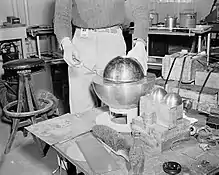tickle the dragon's tail
English
Etymology
From the obvious risk of tickling a dragon's tail. In physics, it was first used by Richard Feynman to describe the experiments of Louis Slotin at Los Alamos National Laboratory.
Verb
tickle the dragon's tail (third-person singular simple present tickles the dragon's tail, present participle tickling the dragon's tail, simple past and past participle tickled the dragon's tail)

A staged reconstruction of Louis Slotin tickling the dragon's tail (sense 3).
- (idiomatic) To do something that has a risk of going catastrophically wrong.
- Climbing so close to an erupting volcano was tickling the dragon's tail.
- (idiomatic) To annoy an irritable person.
- Don't tell him the headline's misprinted; you don't want to tickle the dragon's tail.
- (physics) To bring two subcritical masses close together in order to find the edge of criticality.
- The laboratory head tickles the dragon's tail whenever we have guests as a show of machismo.
- 1957, Jim Harman, “Break a Leg”, in Galaxy Magazine, volume 6, number 1-6, page 130:
- Every real boy likes to tickle the dragon's tail. Maybe I was a little old for it, but that's what I was doing there in the Moran III jungle. I got the shield off my cigarette lighter and jerked out the dinky little damper rods for the pile and started easing the two little bricks toward each other with the point of my lead pencil
- 1993, James Erwin Schevill, 5 Plays 5, page 52:
- PHYSICIST SLOTIN (manipulating the two hemispheres of the bomb at a table): Come closer. Watch me tickle the Dragon's tail
- 1995, George Robert Caron, Charlotte E. Meares, Fire of a Thousand Suns: The George R. "Bob" Caron Story, page 219:
- And so it happened that Japan and the United States had also tickled the dragon's tail. The two subcritical masses called pride and cultural misunderstanding had been shoved together into one critical mass.
- 2003, Jonathan P. Binstock, Jim Sanborn, Atomic Time: Pure Science and Seduction, page 13:
- Were this assembly functional, a person might manipulate the bricks of the radiant castlelike structure to slow down the neutrons, to "tickle the dragon's tail," as Morland writes
This article is issued from Wiktionary. The text is licensed under Creative Commons - Attribution - Sharealike. Additional terms may apply for the media files.